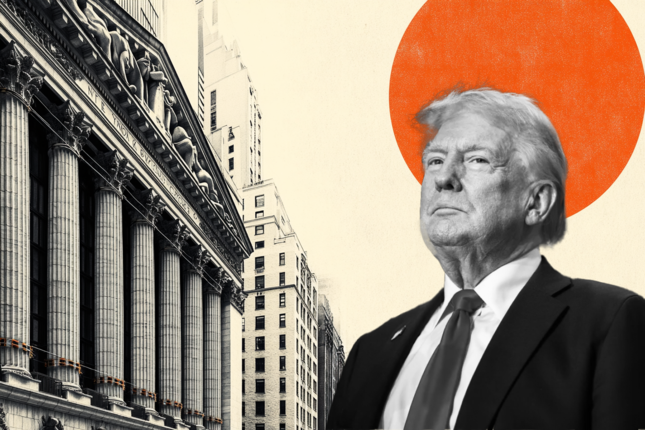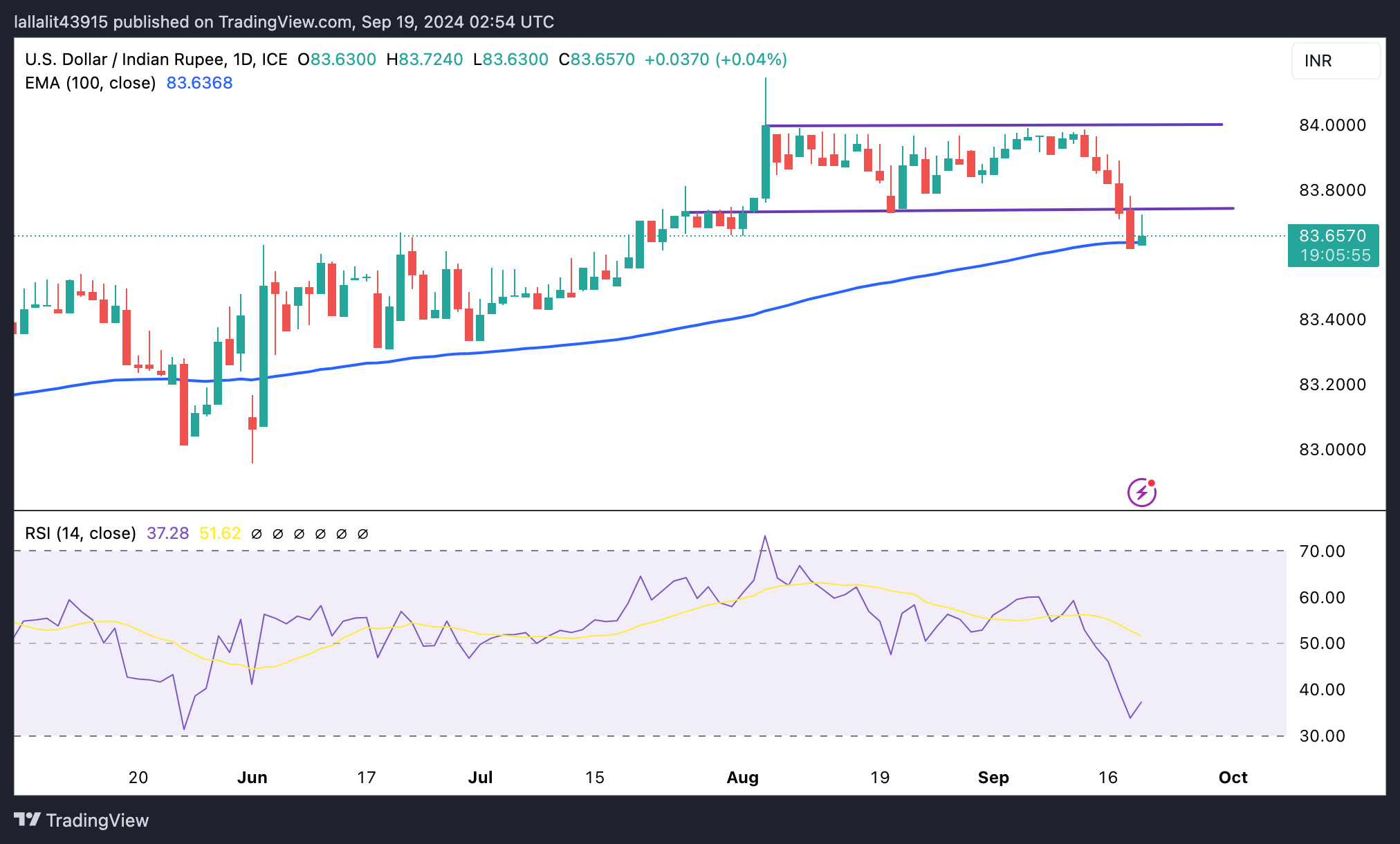- Indian Rupee gathers strength in Thursday’s early European session.
- The increased liquidity flowing into the Indian market and dovish Fed drag the US Dollar down.
- Traders await the US weekly Initial Jobless Claims, the Philly Fed Manufacturing Index and Existing Home Sales on Thursday.
The Indian Rupee (INR) gains traction on the softer US Dollar (USD) on Thursday. The downside of the INR might be limited after the US Federal Reserve (Fed) made a large rate cut at its September meeting, which might weaken the US Dollar (USD). Furthermore, the persistent Foreign Institutional Investor (FII) funds into Indian equities could further strengthen the local currency.
Nonetheless, further rebound in crude oil prices could undermine the INR as India is the third-largest oil consumer after the United States (US) and China. Moving on, investors await the US weekly Initial Jobless Claims, the Philly Fed Manufacturing Index and Existing Home Sales, which are due later on Thursday.
Daily Digest Market Movers: Indian Rupee edges higher after the Fed rate decision
- The Reserve Bank of India (RBI) is unlikely to ease the benchmark policy rate during 2024 given the uncertainty over food inflation, said State Bank of India (SBI) chairman C S Setty.
- Finance Minister Nirmala Sitharaman said on Wednesday that India is standing out globally in terms of economic growth and will continue to do so in the next few years.
- The Federal Open Market Committee (FOMC) decided to lower the federal funds rate by 50 basis points (bps) to a range of 4.75% to 5.00%, the Fed’s first rate cut in more than four years.
- Fed Chair Jerome Powell noted during a press conference that the half-point rate reduction did not represent any new pattern for the central bank but that policymakers want to keep the economy and the labor market in good shape.
- Fed policymakers revised their quarterly economic forecasts, raising the median projection for unemployment by the end of 2024 to 4.4% from the 4% projection in June. Fed officials raised their projection for the long-run federal funds rate to 2.9% from 2.8%.
Technical Analysis: USD/INR’s positive outlook remains fragile in the longer term
The Indian Rupee trades firmer on the day. The USD/INR pair has broken below the rectangle on the daily chart. The bullish outlook of the pair seems vulnerable as the price hovers the key 100-day Exponential Moving Average (EMA). If the pair closes below the 100-day EMA, it could resume the downside. Meanwhile, the 14-day Relative Strength Index (RSI) stands in the bearish zone below the midline near 38.0, suggesting the path of least resistance is to the downside.
The 100-day EMA at 83.64 acts as an initial support level for the pair. A breach of this level could see a drop to 83.31, the low of June 18. Extended losses could attract some sellers to the 83.00 psychological mark.
On the upside, the first upside barrier for USD/INR emerges at the support-turned-resistance level near 83.75. A crucial barrier is seen at the 83.90-84.00 region.
Fed FAQs
Monetary policy in the US is shaped by the Federal Reserve (Fed). The Fed has two mandates: to achieve price stability and foster full employment. Its primary tool to achieve these goals is by adjusting interest rates. When prices are rising too quickly and inflation is above the Fed’s 2% target, it raises interest rates, increasing borrowing costs throughout the economy. This results in a stronger US Dollar (USD) as it makes the US a more attractive place for international investors to park their money. When inflation falls below 2% or the Unemployment Rate is too high, the Fed may lower interest rates to encourage borrowing, which weighs on the Greenback.
The Federal Reserve (Fed) holds eight policy meetings a year, where the Federal Open Market Committee (FOMC) assesses economic conditions and makes monetary policy decisions. The FOMC is attended by twelve Fed officials – the seven members of the Board of Governors, the president of the Federal Reserve Bank of New York, and four of the remaining eleven regional Reserve Bank presidents, who serve one-year terms on a rotating basis.
In extreme situations, the Federal Reserve may resort to a policy named Quantitative Easing (QE). QE is the process by which the Fed substantially increases the flow of credit in a stuck financial system. It is a non-standard policy measure used during crises or when inflation is extremely low. It was the Fed’s weapon of choice during the Great Financial Crisis in 2008. It involves the Fed printing more Dollars and using them to buy high grade bonds from financial institutions. QE usually weakens the US Dollar.
Quantitative tightening (QT) is the reverse process of QE, whereby the Federal Reserve stops buying bonds from financial institutions and does not reinvest the principal from the bonds it holds maturing, to purchase new bonds. It is usually positive for the value of the US Dollar.
Due to the importance of trade to the economy, the Reserve Bank of India (RBI) actively intervenes in FX markets to maintain the exchange rate within a limited range. It does this to ensure Indian importers and exporters are not exposed to unnecessary currency risk during periods of FX volatility. The RBI buys and sells Rupees in the spot market at key levels, and uses derivatives to hedge its positions.
Information on these pages contains forward-looking statements that involve risks and uncertainties. Markets and instruments profiled on this page are for informational purposes only and should not in any way come across as a recommendation to buy or sell in these assets. You should do your own thorough research before making any investment decisions. FXStreet does not in any way guarantee that this information is free from mistakes, errors, or material misstatements. It also does not guarantee that this information is of a timely nature. Investing in Open Markets involves a great deal of risk, including the loss of all or a portion of your investment, as well as emotional distress. All risks, losses and costs associated with investing, including total loss of principal, are your responsibility. The views and opinions expressed in this article are those of the authors and do not necessarily reflect the official policy or position of FXStreet nor its advertisers. The author will not be held responsible for information that is found at the end of links posted on this page.
If not otherwise explicitly mentioned in the body of the article, at the time of writing, the author has no position in any stock mentioned in this article and no business relationship with any company mentioned. The author has not received compensation for writing this article, other than from FXStreet.
FXStreet and the author do not provide personalized recommendations. The author makes no representations as to the accuracy, completeness, or suitability of this information. FXStreet and the author will not be liable for any errors, omissions or any losses, injuries or damages arising from this information and its display or use. Errors and omissions excepted.
The author and FXStreet are not registered investment advisors and nothing in this article is intended to be investment advice.
Recommended content
Editors’ Picks

EUR/USD recovers toward 1.0400 as USD rally loses steam
EUR/USD recovers from daily lows toward 1.0400 in the American session on Tuesday. Following the earlier rally, the USD struggles to preserve its strength as the bullish opening in Wall Street's main indexes point to an improving risk mood.

GBP/USD stays below 1.2300 after UK employment data
GBP/USD rebounds from session lows but remains below 1.2300 in the second half of the day on Tuesday. The US Dollar clings to modest gains but finds it difficult to gather further bullish momentum as the impact of Trump's tariff threats fade.

Gold climbs to fresh multi-month high above $2,730
Gold gathers bullish momentum and trades at its highest level since early November above $2,730 on Tuesday. The benchmark 10-year US Treasury bond yield is down more than 1% below 4.6% following US President Trump's tariff threats, helping XAU/USD push higher.

Bitcoin fails to sustain the $109K mark after Trump’s inauguration
Bitcoin’s price steadies above the $102,000 mark on Tuesday after reaching a new all-time high of $109,588 the previous day. Santiment’s data shows that BTC prices quickly corrected, as social media showed major greed and FOMO among the traders in Bitcoin after President Donald Trump’s inauguration.

Prepare for huge US trade changes as Trump goes America first
You can be sure that big changes are coming as far as US trade is concerned, even if we didn't get any new tariffs on President Trump's first day in office. A comprehensive investigation into US trade relationships was initiated via a memorandum. China, Canada, and Mexico are clearly in the immediate firing line.

Trusted Broker Reviews for Smarter Trading
VERIFIED Discover in-depth reviews of reliable brokers. Compare features like spreads, leverage, and platforms. Find the perfect fit for your trading style, from CFDs to Forex pairs like EUR/USD and Gold.
